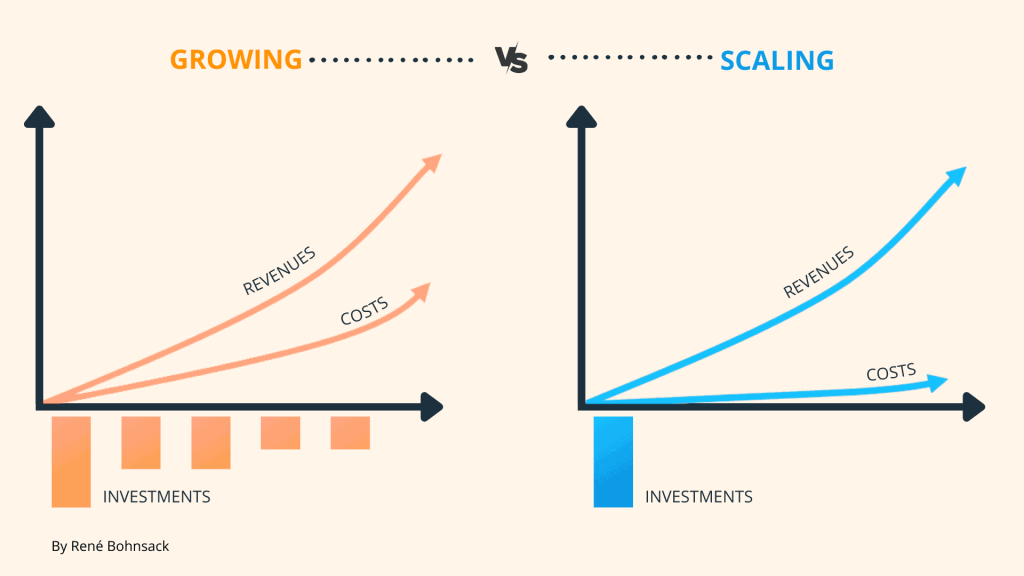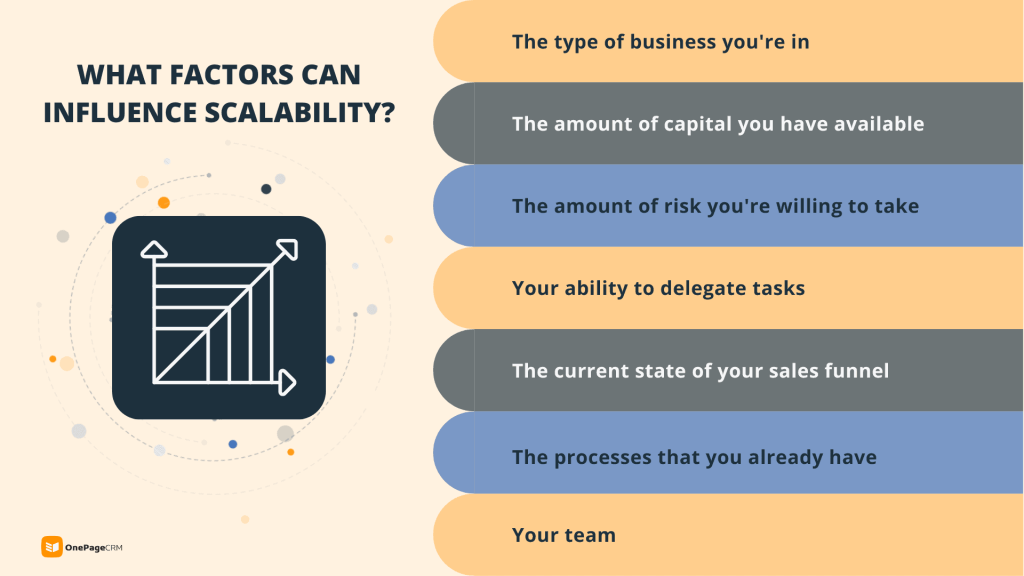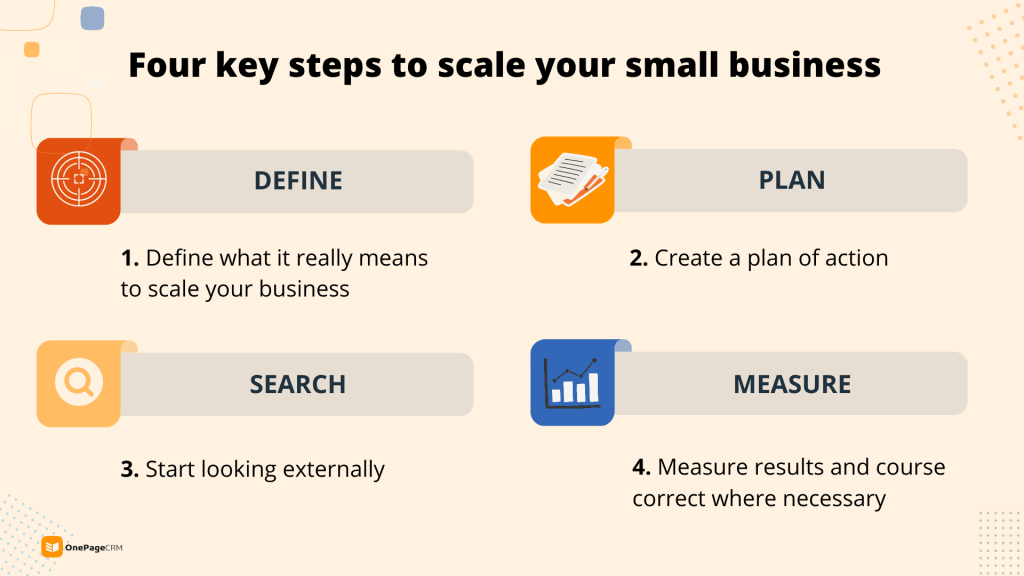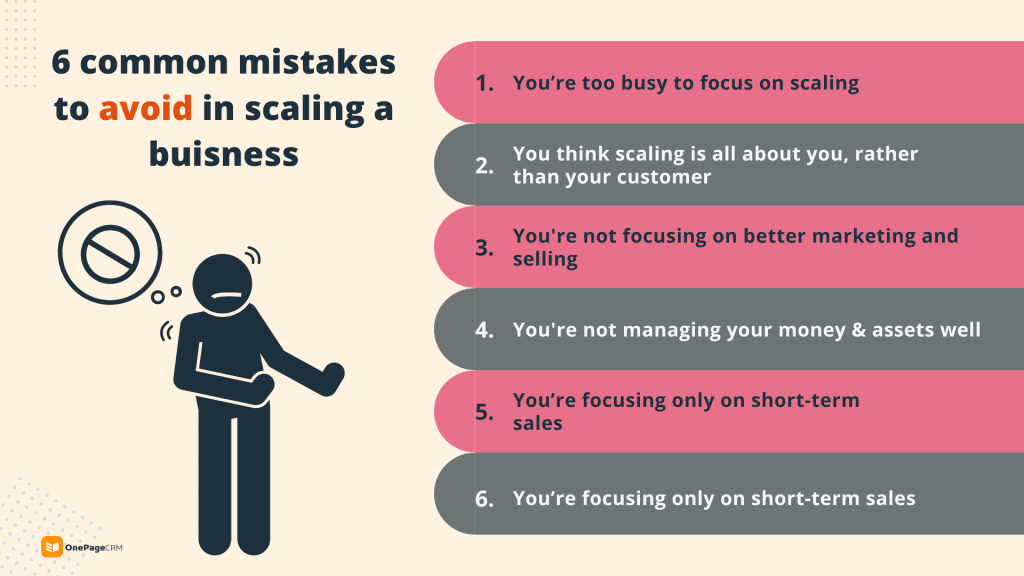
If you have started thinking about taking your business to the next level (and maybe even reducing your workload), you’ve definitely heard about scaling.
While scaling a business is no small feat, it’s possible with proper planning and execution.
In this post, we’ll outline key steps to help you successfully scale your small business while also explaining how to know if you’re ready to take on this challenge.
11 steps to scale a small business
For your convenience, we divided this blog post into different parts. First, we introduce the term and explain how scaling is different from growth.
Then we dive deep into all 11 steps but they are divided into three sets.
The first set of steps is about how to determine if your business is scalable at all. The second set has tips on how to lay a solid foundation for your scaling strategy. And, finally, the third set of steps describes four scaling strategies and techniques.
Here’s the definitive list of all the steps to scale a small business:
- Determine if your business is scalable (4 factors to keep in mind)
- Review your sales funnel and optimize when needed
- Build a strong team and hire the right people
- Standardize processes
- Define what scaling a business means to you
- Create an actionable plan
- Spread the word about your business
- Outsource and hire freelancers
- Keep an eye on the competition
- Network
- Measure results and course-correct when needed
What does “scaling a business” mean?
Scaling in business refers to growing your company to a larger size. This can be done in several ways, such as increasing the number of employees, expanding the product line, or entering new markets.
The goal of scaling is to increase efficiency and grow the business in a controlled manner. This means that you need to have a solid foundation before scaling so that you don’t encounter major problems down the road.
There are several reasons why scaling is essential in business:
- When done correctly, it can help you become more efficient and improve your bottom line.
- Scaling can help you reduce your workload by allowing you to delegate tasks to other employees.
- Finally, it can help you expand your product line or enter new markets.
How is scaling a business different from growing a business?

It’s also important to understand that scaling is different than growth.
Growth might bring with it an increase in costs, something which should be minimized when scaling. It’s also usually harder to sustain as it’s more challenging to pinpoint exactly what causes it.
Scaling, however, is about growing your business in a controlled manner. This means expanding in a way that doesn’t sacrifice your company’s quality or culture.
How to determine if scaling your business is possible
There are several factors that you need to take into account when determining if your business is scalable.

The type of business you’re in
Some companies are simply more challenging to scale than others. For example, a local retail store will be more challenging to scale than an eCommerce business. This is because there are only so many locations that a retail store can be in, and it’s challenging to reach new markets without incurring a lot of expenses.
The amount of capital you have available
If you don’t have much money, it will be challenging to scale your business since you’ll need to invest in things like hiring new employees, expanding your facilities, or developing new products.
The amount of risk you’re willing to take
Scaling often requires investments in areas that might not pan out. As such, risk tolerance is an important factor to consider when determining if your business is scalable.
Your ability to delegate tasks
Without a team in place to handle the increased workload, you’ll quickly become overwhelmed and won’t be able to effectively scale your company. Since you might not have the resources available to support a more extensive operation, you’ll need a larger team.
3 steps before scaling a small business
If you’ve determined that scaling is the right move for your business, here are three steps that will help you do it right:
- Have a thorough review of your sales funnel
- Build a strong team
- Standardize processes
1. Have a thorough review of your sales funnel
Understanding the various sales funnel steps is critical to scaling your business. This is because your sales funnel will indicate where your customers are in their buying journey and what needs to be done to move them further down the funnel.
With many sales funnel software, looking at analytics is as easy as pie, allowing you to quickly and easily understand your conversion rates at each funnel stage.
Once you have this information, you can start thinking about improving your funnel so that more customers convert into paying ones and, in turn, paying customers become long-term brand advocates.
2. Build a strong team
If you’re going to scale your business, then you need to have a strong team in place. This team will need to be able to handle the increased workload that comes with a more extensive operation.
Having people who are not specialists but generalists can help you in the scaling process. These team members are excellent at handling various tasks and can be trained relatively easily when it comes to scaling operations.
Getting specialists into the business will need to happen at a certain point, but for scaling purposes, having a generalist approach can help in several areas.
3. Standardize processes
Finally, the third step you must take before scaling your business is to standardize processes (and make sure that they are working).
As your business grows, you will need to have systems and processes in place, so everyone knows what needs to be done and how it needs to be done. This will help ensure that things run smoothly and that there is less room for error.
Part II: 4 steps for scaling a small business successfully
Let’s now put the above into practice with four key steps to help you scale your small business:
- Define what it really means to scale your small business
- Create an actionable plan
- Spread the word about your business
- Measure results and course correct where necessary

1. Define what it really means to scale your business
Different businesses have different definitions of what it means to scale their business. Some business owners might think that growing their customer base by 20% is scaling, while others focus on hiring more employees.
The first step in scaling your business is to define what it means for you.
Consider these questions:
- What are your goals and objectives?
- What does success look like for you?
- Do you want to scale revenue/number of customers?
- If not, what is the defining metric?
No matter your definition of success, it’s essential to have a clear idea of what you’re aiming for. This will make creating an actionable plan and tracking your progress easier.
Once you have a clear definition, you can start planning how to achieve it.
2. Create an actionable plan
Setting goals is an essential part of any business planning process, and it’s no different when you’re scaling your small business. But you need to be realistic about what you can achieve.
For example, if you want to increase revenue by 20%, you need to identify the steps you need to take to reach that goal. Are you going to need to hire more employees? Increase your marketing budget? Or introduce a new product or service?
Whatever your goals may be, make sure they are specific, measurable, and achievable. This will help keep you on track and progress towards scale.
Here are a few things to keep in mind:
- Align goals with your overall business strategy. If your plans are not in line with your business strategy, you’ll likely find it challenging to achieve success. For example, if you’re trying to increase revenue by 20% but don’t have a plan to increase sales, you’re not going to get very far.
- Be specific about what will happen and who will be responsible for each task. You might want to create a timeline or Gantt chart to help visualize the process and ensure everyone is on track.
- Discuss the plan with stakeholders and get buy-in. You need to get buy-in from employees, shareholders, and other key people. This will help ensure everyone is on the same page and aware of the changes that need to be made.
- Consider how the plan will be tracked. Similar to how you set a target to measure progress when setting up a productive workflow, being able to measure progress towards scaling is critical to ensuring success.
3. Start looking externally
Once you have a good team, good processes, and a good product, it’s time to start looking externally.
The more people who know about your business and what you have to offer, the more likely you are to achieve success.
Spread the word about your business
This might include several activities, such as:
- Expanding your online reach through social media or PR.
- Building partnerships with other brands.
- Establishing yourself as a thought leader in your industry through creating high-quality and unique content.
Scaling a small business requires a certain level of proactivity, consistent outreach, and regular features in relevant publications.
Outsource and hire freelancers
As your business grows, you’ll quickly realize that you can’t always do everything internally.
Delegating tasks to contractors or even virtual assistants can help free up your time so you can focus on more critical tasks. But make sure that the person you’re delegating to is qualified and capable of completing the task. You should also provide clear instructions and expectations.
Research your competitors
Staying ahead of the competition is critical in any industry, but it’s imperative when scaling a small business. Consider and observe what your competitors are doing and what has worked for them.
See if you can implement similar strategies in your own business. Also, keep an eye on emerging trends in your industry they seem to be following so you can also capitalize on them. That said, if you can be the first to notice a trend, it gives more power to your business.
Here are some ideas on how to stay up-to-date with what your competitors are doing:
- Sign up for their newsletter
- Follow them on social media
- Use a social listening tool to get notifications whenever they’re mentioned online
Get smart at social listening
Nowadays to get social is to get smart.
We’re not suggesting you spend an hour of your day creeping on your best friend’s work colleague and pawn it off as ‘market research’. We’re talking smart, efficient use of social listening tools to gain real market insights.
If you’re using Twitter or LinkedIn for prospecting or staying in touch with your clients, it’s called social selling. To put it simply, social selling is a process of building relationships with potential and existing clients via social media.
Social selling isn’t a new concept. It’s very similar to networking but can be done with the help of social media tools and should focus on quality not quantity.
Improve your networking skills
Networking can help you make industry connections, find new customers, and even get access to capital. As your business grows, you’ll have more opportunities to network with other professionals.
Make sure you’re networking regularly and building relationships with people who can help you grow your business. Attend industry events, join relevant online communities, and connect with other small businesses in your area.
4. Measure results and course correct where necessary
As your business grows, your goals and strategies will undoubtedly change.
Regularly reviewing your progress toward your goals is essential for keeping your business on track. Make sure you’re measuring the right metrics and making adjustments as needed.
Also, keep in mind that reviewing the tools you use to measure success regularly will help you determine whether they’re still the best fit for your business.
For example, if you’re using social media to market your business, you’ll want to review your analytics regularly to see how well your content is performing. If you’re not getting the desired results, consider trying a different approach.
Finally, consider what course correction looks like. While many businesses consider themself flexible before scaling, the truth is that once you’re in growth mode, there’s often less room for error.
This means that if something isn’t working, you need to be able to quickly course-correct it by reverting to a Plan B. This could involve changing your budget, hiring new employees, or even pivoting your business model altogether.
At the same time, remember that course correction doesn’t have to be a significant change. Sometimes, minor tweaks can make a big difference. The important thing is that you’re constantly assessing your progress and making adjustments as needed using plans that have already been drawn up.
Six common mistakes to avoid when scaling a small business
Here are some of the biggest mistakes you can make when scaling a small business:
- You’re too busy to focus on scaling
- You think scaling is all about you, not your customer
- You’re not focusing on better marketing and selling
- You’re not managing your money/assets well
- You’re focusing only on short-term sales
- You’re competing on price

1. You’re too busy to focus on scaling
Scaling a small business takes a lot of work. It can be downright overwhelming at times. If you’re too busy with day-to-day operations, you won’t have the time or energy to focus on scaling your business.
To avoid this, ensure you’re delegating tasks and creating systems that will allow you to focus on value-add tasks. You can hire new employees, automate processes, or even outsource some of your work.
2. You think scaling is all about you, not your customer
When scaling a small business, getting caught up in everything you need to do is easy. However, it’s important to remember that your customers should always be your top priority. After all, without customers, you wouldn’t have a business to scale.
As your business grows, ensure you’re still providing the same high level of service and meeting your customers’ needs.
3. You’re not focusing on better marketing and selling
Investing in marketing and sales initiatives will help you reach your target market is crucial. You might consider SEO, content marketing, social media advertising, paid ads, email marketing, SMS marketing.
Whatever the channel, make sure you’re using it effectively to reach your target market.
Additionally, ensure you train your employees to sell your products or services effectively. The more knowledgeable (and passionate) they are about your business, the easier it will be to close deals and grow your revenue.
4. You’re not managing your money/assets well
If you want to scale your small business, you need to be diligent about how you’re managing your money and assets.
This means creating a budget and sticking to it. You should also have systems in place to track your expenses and income. This way, you can see where your money is going and adjust as needed.
5. You’re focusing only on short-term sales
When scaling a small business, it’s easy to get caught up in need for immediate sales. However, focusing on building long-term relationships with your customers is no less essential.
Short-term sales are not sustainable in the long run. To scale your business, you need to focus on building relationships by providing an exceptional customer experience, developing a solid brand, and offering quality products or services.
6. You’re competing on price
When scaling a small business, you need to focus on creating value for your customers. This is how you’ll differentiate yourself from your competition.
Therefore, don’t get caught up in competing on price. Instead, focus on creating a unique selling proposition to make your business stand out.
Scaling a business is all about value and focus
As you scale up, never stop striving to provide more value for your customers. This can involve expanding your product offerings, improving customer service, or providing more unique selling points. By doing this, you’ll be able to keep your business growing long-term.
Finally, always consider the question of how your customer will benefit from your decision to scale up.











